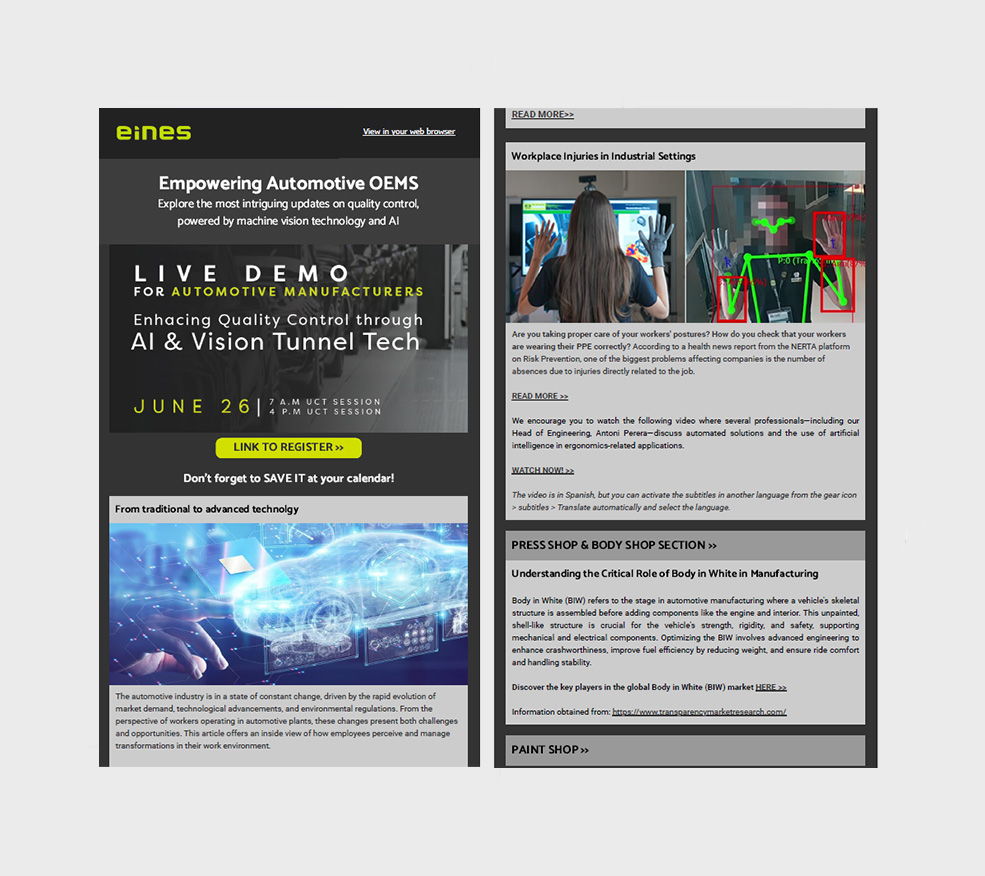Over the past few months, EINES has conducted a series of webinars aimed at OEMs and Tier 1 suppliers in the automotive sector. As part of these sessions, a detailed survey was carried out to assess the level of technological maturity in inspection processes, key quality concerns, and the level of interest in new solutions such as machine vision tunnels, metrology stations, augmented reality, and automated inspection for electric vehicle batteries.
Below, we present the most significant findings, highlighting key data that reflect both current trends and the future direction of quality control in the automotive industry.
Key Quality Concerns
Respondents clearly identified the types of defects that most impact their operations:
- Paint defects, cited by 72% of respondents
- Surface damage on body panels, present in 65% of cases
- Panel misalignment (Gap & Flush), highlighted by 60%
- Missing or incorrect exterior components, a concern for 48%
- Traceability and error analysis, crucial for 52%
These results confirm that surface quality and dimensional accuracy remain critical issues in the manufacturing process, directly affecting the final product’s image and generating significant rework and warranty costs.
How is Inspection Currently Performed?
Manual visual inspection by operators is still the predominant method, used by 80% of participants. Only 15% reported using fixed cameras or automated tunnels, and less than 5% are currently employing robotic inspection systems.
This suggests a substantial opportunity for automation—especially considering that:
- 100% of final assembly plants still rely on manual inspection
- Only in paint shops and body shops has some degree of automation begun to take hold.
Which Solutions Generate the Most Interest?
Among the proposed technologies, the following solutions stood out as the most appealing:
| Solution | % of interest |
| All-in-One Tunnel | 81% |
| Tunnel for Paint Defect Inspection | 72% |
| Tunnel for Gap and Flush (3D Metrology) | 63% |
| Tunnel for Surface Damage Inspection | 58% |
| MEP Stations (interior and end-of-line) | 54% |
| Digital Assistant/Dashboard | 41% |
| Augmented reality for assembly support | 36% |
Notably, 94% of respondents expressed interest in receiving more information about these solutions, indicating a strong appetite for transitioning toward a more connected and digitized approach to quality control.
How Well Are These Technologies Known?
- 45% of attendees were introduced to these solutions for the first time during the webinars.
- 35% had heard of them but were not familiar with the details.
- Only 20% had prior knowledge through direct or third-party experience.
This highlights the importance of technical education and outreach in accelerating adoption of new tools across the industry.
Processes with Highest Automation Interest
Respondents identified several key processes they would like to automate:
| Interior Parts Assembly (doors, headliners, panels) | 61% |
| Battery and engine assembly | 48% |
| Wheel mounting | 32% |
| Final assembly (complete vehicle check) | 52% |
| Body Shop (welds, holes, bolts) | 29% |
| Presence/absence control and OCR | 62% |
| Electrical checks and light continuity | 49% |
| Automated metrology | 57% |
Supporting Technologies: AR, AI, and Robotics
| Augmented Reality (AR) | Robot Guidance and Machine Vision |
| 50% of participants were unfamiliar with AR solutions applied to quality control. However, 89% showed interest in integrating it—particularly for assisted assembly stations, ergonomics analysis, and PPE detection | 3D robotic guidance systems using machine vision are starting to gain traction, especially in applications such as: – Door and window assembly – Sealant application – Automatic IP insertion – Battery air leak testing |
Economic Impact of Defects
| Report Rework and reprocessing as a direct consequence | 84% |
| Face costs realted to warranty claims, labor and discarded parts | 76% |
| Recognize the impact on competitiveness | 28% |
| Cite damage to brand image | 25% |
Despite these consequences, only 8% of companies have concrete plans to implement automated paint repair systems within the next year, while 60% still have no clear strategy in place.
How are Quality Data Used today?
One of the most revealing findings is the limited use of quality-related data:
- 30% do not store the data at all
- 35% use it only for basic reporting or traceability
- Only the remaining 35% actively use it for process improvement or error prevention
This shows the untapped potential of advanced analytics, cloud integration, and big data for driving smarter quality management.
Conclusion: An Industry in Transition Toward Digitalization
This survey leads to a clear conclusion: interest in digital quality control solutions is very high, but adoption remains uneven. Many plants still rely on manual inspection with little to no digital traceability or analytics. Meanwhile, others are beginning to explore automation through machine vision, robotic guidance, automated metrology, and augmented reality.
The automotive industry is clearly transitioning toward a more connected, intelligent, and traceable approach to quality—where data becomes a strategic asset for anticipating defects, improving efficiency, and protecting brand reputation.
At EINES Vision, we are committed to supporting this transformation with robust, flexible, and future-ready solutions tailored to the evolving needs of the industry.







